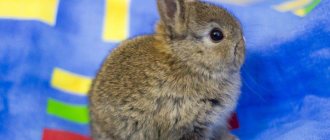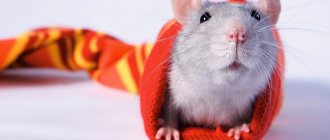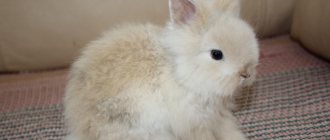Rabbits are becoming increasingly popular pets today. They are cute, sociable and playful, which attracts people's attention to them. However, these animals are also distinguished by their intelligence. With skillful approach, they can be taught different tricks. Let's talk about how to train a rabbit.
Decorative rabbit
Nutrition and maintenance
The vessels include feeding a small and already grown rabbit.
Small
Often, having purchased a baby rabbit, people make the mistake of believing that the little eared rabbit itself knows how much it has to eat. But up to 6 months he is still just a baby. Decorative rabbits move less, sleep more, they do not have stressful situations, so metabolic processes are slowed down, and excess food can lead to obesity.
Let us remind you that you can find some information on nutrition in the article - what to feed a decorative rabbit at home. You will develop rules and feeding patterns over time. Rabbit breeders recommend giving 2 tablespoons of feed and observing the animal. If by the evening he eats everything, then give him another equal portion. If not, then give 1 spoon in the morning, and 3 in the evening. Sometimes the animal does not eat three spoons of food during the night, then give two. It is impossible to increase the amount of feed; it is better to give more hay.
grown up
Adults are fed once a day, giving them no more than 4 tbsp. food. To diversify your pet’s diet, you can pamper him with the following: twigs of coniferous trees (cedar, fir, pine, juniper and spruce), raisins, dried bananas, dried apricots (tiny pieces 1-2 times a week), cabbage (except white cabbage), radishes , carrots, cucumbers (in small portions), beet tops, carrots, dill (if you have your own garden). It is strictly forbidden to give sweets, potatoes, milk, white cabbage, plums, grapefruits and oranges.
Basic rules of care:
- New food should be introduced gradually, without mixing with other and tiny portions.
- The water must be clean and settled.
- There should always be hay in the manger.
- To sharpen the rabbit's teeth, give branches of birch, alder, apple, willow, and pear.
- Before giving food (fruits, vegetables, leaves, etc.), be sure to wash and dry them.
- Hang a mineral salt stone.
- Do not serve food from the common table.
How to avoid harm with treats?
Some foods are completely contraindicated for rabbits; poor nutrition is one of the most common causes of death for pets.
- Sugar, candy and chocolate contain unhealthy fats, and large amounts of sugar can cause death;
- Boiled and canned vegetables and fruits are unnatural food for rodents; bites, seasonings and other dangerous components can cause serious digestive problems;
- Fried foods can cause liver and kidney disease;
- Milk, kefir, cottage cheese, yogurt can lead to serious illnesses;
- Rusks, wheat and rye bread create a feeling of fullness, the rabbit may refuse other food;
- Cookies and muesli contain sugar, dyes, salt, and food additives. These products are extremely harmful to domestic herbivores.
Distinctive features of decorative rabbits
Decorative rabbits have a number of distinctive features over ordinary meat breeds.
- Meat rabbits are mainly bred in rural areas and on farms for meat and skins; decorative rabbits are bred only as cheerful pets.
- Light weight and size are a distinctive feature of decorative rabbits.
- The shape of the ears of these animals is very diverse and is often a source of pride for them. Depending on the characteristics of the breed, it can be hanging, rounded, with tassels at the ends.
- Different living conditions for decorative and ordinary rabbits affect their life expectancy. If the life of an ordinary rabbit is 7-8 years, then a decorative one, growing in love and hourly care, can live 10-12 years.
Gender of the rabbit
Some owners dream of having a decorative rabbit of only a certain gender. This may be due to a variety of reasons. So how not to make a mistake when determining the gender of your future pet?
The main and main difference is the structural features of the reproductive organs of animals. It is very difficult to independently determine the sex of small rabbits under the age of one month; a highly qualified specialist with experience can help with this.
In adult individuals, the external features of the structure of the genital organs are more clearly expressed and the gender of the rabbit can already be determined independently, almost without error.
Rabbit age
In the event of various diseases, as well as during the introduction of preventive vaccinations, it is necessary to determine the age of the animal.
It is worth paying attention to some external features:
Claw length
An important age characteristic of rabbits is the length of their claws. The older the animal, the more the claws bend inward. Ribs
Until the age of six months, a rabbit's ribs are very soft to the touch. Teeth If you pay attention to the teeth of rabbits older than six months, they will have a yellowish tint and become covered with plaque. The eyelids of adult animals have a lumpy, drooping shape, while in young animals they are smooth and even.
All these signs are very relative and no veterinarian will be able to accurately determine the age of the animal from them. In order to avoid problems in the future, it is advisable to purchase a decorative rabbit in specialized nurseries, where all the necessary documents are drawn up immediately after birth.
Allergy to rabbits
Quite often, people with allergies, who are hypersensitive to certain components of the external environment, decide to purchase a decorative rabbit as a pet.
This is because the fur of rabbits is different from the fur of dogs and cats and rarely causes an allergic reaction. But elements of the excretory secretions of rabbits can be strong allergens for humans. Often, food is also the cause of an allergic reaction.
In case of allergic reactions, a laboratory blood test will allow you to find out what exactly was the allergen in this case.
Smell of a rabbit
Male rabbits produce more odorous substances and have a natural tendency to mark their territory. This behavioral characteristic is much less common in females. However, female rabbits are more prone to damaging property: when arranging their nest, they can use everything that catches their eye.
Rabbit teeth
The structural features of the jaw of rabbits are determined by the plant foods they consume. In total, decorative breeds of rabbits have 28 teeth. To bite off food, the rabbit uses six incisors and chews it with 22 molars.
A rabbit's incisors are constantly growing, so these animals need roughage first of all. Decorative rabbits have no fangs.
What breeds can be trained?
Rabbits of different breeds have different types of temperament, but most of them show learning abilities. If you want to get an eared pet and then teach him various tricks, you should pay attention to the following breeds:
- Flanders, the gray and white giants. These related breeds have a good-natured nature. Cute animals easily find contact with people, are tamed and trained.
- Shorthaired dwarf. The miniature animal will become a good friend for families with children and single people. Having learned to trust the owner, the animal will be able to master interesting tricks.
- Dutch. Representatives of this breed love to play, they are sociable and active.
- The Angora dwarf is a fluffy animal with a good-natured character. The Angora rabbit is a little lazy, but smart.
- The lop-eared ram is distinguished by its playfulness and ability to find a common language with people.
- The dwarf rex is smart and aristocratic, amenable to training.
Reference. Dwarf breeds love to play; they perceive training not as a need to follow the owner’s commands, but as entertainment.
What do rabbits need for a comfortable life?
If you have decided on the breed, then you can safely move on to preparing for the arrival of a new pet in the house.
Remember, first you buy the cage and its accessories, and then only the rabbit! What are these add-ons? And this is a drinking bowl, a wheel (rabbits love to run), a tray, toys (all kinds of small balls).
You need to immediately purchase a larger cage, as rabbits grow quickly. The standard size is one meter.
A comfortable temperature is plus 18-20 degrees, and relative humidity is 50 percent.
Do not place the enclosure in direct sunlight as rabbits are very sensitive.
In the rabbit’s “house” it is necessary to make flooring (hay) approximately three to five centimeters thick. Replacement should be done every two weeks (rabbits are clean).
The tray needs to be cleaned daily.
Secure everything tightly. If something comes off, your pet will start gnawing on it.
The bottom of the enclosure should not be slippery. A lattice bottom is absolutely not suitable, as the legs will fall through.
Rabbits are sensitive and can catch cold from any draft. You cannot place the cage near air conditioners and radiators.
Rabbits eat hay, food and water. Additives include greens, fruits, vegetables. In the summer there is no need to completely replace hay with fresh grass.
Decorative rabbits are cowardly, so hold them tightly in your arms, as they can jump out and hurt themselves. A rabbit can die if it jumps from a certain height.
It is strictly forbidden to have a baby rabbit if you have small children. They can grab him by the ears, pull his fur, and this can lead to stress in the pet (rabbits often begin to get sick).
The rabbit needs walks and games, it must be active
It is important not to let him go for a walk unattended (he may chew something dangerous to his health)
There are two points of view regarding vaccinations: the first is that they should be given even if the rabbit does not go outside for a walk; second, there is no need to install them if the rabbit lives at home and does not go outside. The decision to vaccinate is yours to make.
If, after reading our article, you are still confident in your decision to get a rabbit, then here are six tips for making a smart purchase.
1. It is better to buy a decorative rabbit from breeders or in a nursery, but not in a store (often they do not monitor the animal, and there is no absolute guarantee that you will buy a healthy animal).
2. Find out the age of the rabbit; you should not buy a baby rabbit if it is not one and a half months old.
3
Pay attention to the wool, it should be shiny, without bald spots, tangles, etc.
4. The rabbit’s skin should be free of spots, redness and various growths.
5. The rabbit should be of medium size, active, cheerful.
6. When purchasing, find out about the conditions of keeping your decorative rabbit (what he was fed, what he was accustomed to, etc.).
Good luck to you and your pet!
Integrate Pravda.Ru into your information flow if you want to receive prompt comments and news:
Subscribe to our channel in or
Add Pravda.Ru to your sources in Yandex.News or News.Google
We will also be glad to see you in our communities on Facebook, Twitter, Odnoklassniki...
Teaching a rabbit simple commands
Before starting training, you need to draw up a plan for the trick: write down the sequence of actions and commands in order to repeat them without changes. This way the pet will remember what a certain word means and how it should act. The delicacy serves only as a sign that he understood the owner correctly. The main thing in training is to develop a language of communication with the animal.
Name
In order for a rabbit to remember its name, it must be short with hissing and whistling sounds. The animal must be called, offering food. Accustoming to a name takes place successfully during the period of adaptation to a new place.
Making a stand
To instill discipline in a rabbit, start with a simple exercise:
- put the animal on the floor;
- lift with one hand by the front legs, saying “stand”;
- show the treat with the other hand and pull it up so that the rabbit also reaches;
- hold the treat over your pet's head and gradually remove your hand from under its paws so that it stays in a straight position.
The exercise can be divided into two stages: first learn a handstand, and then gradually remove your palm.
Jumping over obstacles
How to master rabbit show jumping:
- install a low obstacle;
- bring him on a leash and slightly pull him forward so that he jumps;
- If your pet slows down in front of an obstacle, lure him with a treat and use a leash to set the direction, giving the command “jump.”
When the rabbit has mastered the low jump, the leash can be removed and the jump bar placed higher.
Turn over the saucer
How to teach an animal to turn over a flat plate:
- put a treat in front of him and cover it with a saucer;
- give the command “search”.
See also
Is it possible to keep rabbits and chickens in the same room, pros and consRead
In order for your pet to gain dexterity, you can start with a deeper and lighter dish - a plastic cup. Then cover the food with a ceramic bowl, and then move on to the saucer.
Facts about rabbits
- They are often confused with hares, but this is not true. There are many differences between them, despite the fact that they are related in the biological sense.
- Wild rabbits can reach speeds of up to 50-55 km/h when running.
- All 16 species of American rabbits live in forests and swamps and do not dig burrows. In addition, they are excellent at climbing trees. And outside of North America, all rabbits live exclusively in burrows and do not know how to climb trees (interesting facts about North America).
- Rabbits and rodents like hamsters and rats share a common ancestor that lived many millions of years ago. However, they still do not belong to rodents.
- North America is home to more than 50% of all rabbits in the world.
- Wild European rabbits dig deep and branched burrows, which sometimes combine into entire underground cities.
- American rabbits are solitary, while all other species usually live in groups.
- In the wild, rabbits are hunted by all and sundry. The only thing that saves them from extinction is that they reproduce at an incredible rate.
- In case of danger, these animals prefer to run away, but if they are driven into a corner, they go for broke and try to defend themselves. With a blow from its powerful hind legs, armed with sharp claws, a harmless rabbit can easily kill or seriously injure a predator.
- They chew very quickly. When a rabbit feeds, its jaw makes an average of two chewing movements per second, and it can chew like this for a very long time without getting tired.
- The weight of adult individuals of the largest wild species usually does not exceed 3.5-4 kg, but domestic rabbits can weigh up to 10-11 kg.
- There were no rabbits in Australia until they were introduced there in the late 18th century. Since then, they have proliferated monstrously and become a serious threat to the ecosystem. They were shot, protective fences were erected against them, and in the middle of the 20th century a special virus was spread among them, which reduced their population to acceptable levels (interesting facts about Australia).
- Due to the fact that rabbits are easy prey, on average they live in the wild for no more than a year. But their domestic species can live 10-12 years if they are provided with appropriate care. The official record is 19 years.
- Their hind legs allow them to jump up to 2-3 meters in length and 1-1.5 meters in height.
- Nature has adapted rabbits' eyes for excellent visibility so that they can always see a sneaking predator. So, rabbits even see what is happening behind them without turning their heads.
- Like people, these animals can actually die from fear if they are particularly frightened.
- Rabbits' foot pads may become sweaty in hot weather.
- Female rabbits have a double uterus, which allows them to simultaneously carry two generations of offspring, from different males.
- On average, rabbit ears are 8-12 centimeters long, but a domestic rabbit whose ears reached a length of 80 centimeters was included in the book of records.
- Some of their breeds become sexually mature as early as 3 months of age. This partly explains their fertility.
- Rabbits give birth to many offspring at one time, but the female herself usually cannot produce all the newborn rabbits. If she gets help, they can all survive. The official litter record is 24 rabbits at one time.
- These animals drink a lot of water. Thus, a rabbit weighing a couple of kilograms can drink more than a dog five times its weight.
- During the era of sailing ships, in the 17th and 18th centuries, sailors often released rabbits on deserted uninhabited islands. This was done so that if people ended up on the island as a result of a shipwreck, they would have a source of food.
- The Aztecs discovered alcohol when they found rabbits drunk after eating some fermented cacti.
- In the Australian state of Queensland, it is legally prohibited to keep rabbits, even ornamental breeds. Violators face a fine of 30 thousand Australian dollars.
- There are about 17 thousand taste buds on a rabbit's tongue.
- Rabbits actually have many more teeth than meets the eye - as many as 28.
Breeding decorative rabbits at home
Breeding decorative rabbits at home
Domestic rabbits, like their wild counterparts, can give birth up to 8 times during the year. High fertility is due to the large number of predators in the natural habitat. The minimum age suitable for breeding in small breeds of rabbits is 6-7 months, and in larger breeds it is several months longer.
Note! There are special cages for female rabbits, which are necessary for the mother’s comfortable well-being and her care for the offspring in the future. The location of the cage must be protected from unwanted influences in the form of loud sounds and outside interference
The location of the cage must be protected from unwanted influences in the form of loud sounds and outside interference.
Keeping a decorative rabbit can bring a lot of pleasure to the owner if he shows care and affection towards the animal. Before going to the pet store, it is recommended to learn as much as possible about this type of animal in order to accurately determine whether it will always be desirable and interesting, or whether it is better to choose another animal that is easier to care for.
https://youtube.com/watch?v=L0-kQddouOQ
Taming process
You should start taming an animal from the first days of its stay in the house.
It is important to understand that the rabbit itself is not aggressive, it is a kind and sweet creature, but very timid. It is fear that gives rise to aggression and reluctance to communicate. It is necessary to ensure that the animal learns to trust its owner
As soon as the animal feels that the person does not pose a danger to it, it will begin to show tenderness
It is necessary to ensure that the animal learns to trust its owner. As soon as the animal feels that the person does not pose a danger to it, it will begin to show tenderness.
In the first few days after buying a rabbit, you should give it time to get used to its new home. Let him get comfortable, sniff his possessions, eat and calm down. When the rodent finds a place to rest, you can begin to get to know it. At first it is better not to pick him up, but only talk to him in a gentle voice through the bars of the cage.
Important! The animal must get used to the smell of the owner, so it is worth refusing to use perfume for the duration of the acquaintance. Some treats, for example, a piece of fresh carrot, will help reduce the animal’s stress level. Offer him a vegetable by slowly extending your hand
At first, the animal will be distrustful of such contact, but the smell of the treat will attract it. Each time you treat the animal with something tasty, you can achieve its favor. Over time, the animal will stop being afraid
Offer him the vegetable by slowly extending your hand. At first, the animal will be distrustful of such contact, but the smell of the treat will attract it. Each time you treat the animal with something tasty, you can achieve its favor. Over time, the animal will stop being afraid
Some treats, such as a piece of fresh carrot, will help reduce the animal’s stress level. Offer him the vegetable by slowly extending your hand. At first, the animal will be distrustful of such contact, but the smell of the treat will attract it. Each time you treat the animal with something tasty, you can achieve its favor. Over time, the animal will stop being afraid.
When letting your rabbit out of the cage for a walk around the apartment, you need to speak to him kindly. You shouldn’t pick it up right away; let it explore the new territory. Just extend your palm to him and lightly touch his fur. Always have a treat ready. Soon the little ear will begin to perceive its owner as a breadwinner and will cease to feel fear. When the degree of trust increases, you can try to hold the little rabbit in your arms for a while.
Attention! Never pick up an animal from above - this is what wild animals do. Hold your pet's lower body with your hand. Mistaking the owner for a dangerous object, an ornamental rabbit can die from a heart attack
Mistaking the owner for a dangerous object, an ornamental rabbit can die from a heart attack.
Veterinarians and experienced breeders give valuable advice on taming these animals:
Animal Taming Tips
- You cannot stand over the animal or its cage. The rabbit sees a person as a large spot; he can perceive him as a dangerous object.
- It is forbidden to suddenly grab the baby rabbit by the ears or paws or forcefully pull it out of the cage.
- You should not make noise in the presence of your pet.
- When petting a rabbit, your hand should be held above its head, not in front of its muzzle.
How to avoid diseases
In a greenhouse, it is impossible to achieve a level of sanitation comparable to cage housing. Feces and urine scattered throughout the area contribute to the development of coccidiosis. Therefore, animals must be given coccidiostats in a timely manner.
In winter, rabbit breeders fear frost. But he is not afraid of rabbits. And the greenhouse does not warm them, but only protects them from the wind. But due to the design features, excess moisture is created inside. Especially when there are a lot of animals. Such conditions contribute to the development of many diseases. The situation is aggravated by the evaporation of urine and the increased concentration of ammonia in the air. There must be ventilation.
When kept for walking in winter, it is better to plant only females in the greenhouse. The presence of males leads to indiscriminate mating. And if there are several of them, it leads to constant fights. Therefore, males must be left in cages.
If you spend time once and adapt the greenhouse to keep rabbits, you will get a full winter run for all subsequent years. This means you use the favorable summer time to maximize the reproduction of your herd. At the same time, after winter you get well-fertilized soil and high yields in summer.
Precautions when working with rabbits
Keeping rabbits in an apartment does not mean that the pet will be in a cage all the time. The animal needs space to run around. This is very important for his normal development and health. When releasing your pet from the cage, you need to:
- Make sure that the rabbit does not chew through electrical wires. This is very dangerous; your pet can die if exposed to electrical voltage;
- jumping from a height, for example, from a bed, the animal can injure its limbs;
- when the rabbit walks around the apartment, you need to keep the balcony door closed;
- When closing the doors, you need to look around so as not to accidentally trap the rabbit.
Are decorative rabbits trainable?
A rabbit is no less a smart pet than a cat or dog. To reveal all the talents of a little fluffy ball, you need to be patient, show care, affection and show a good attitude towards your pet.
During training, it is necessary to repeat the commands repeatedly; the rabbit will soon remember them and will carry them out without much effort. Trained animals can wash their faces while sitting on their hind legs, can run fast, jump high and surprise with other tricks.
You shouldn't train a rabbit if it's not in the mood. Nothing good will come of this. Pets are vindictive, so they will retaliate by making a puddle near the toilet or ruining a child’s toy.
Training for a rabbit is a kind of game that gives him pleasure. When he himself is interested in the game, learning will not be burdensome for him.
When can you start training
Rabbits rarely know their owner from birth. They usually end up in a new home after being weaned from their mother. It is important to give such a pet time to get used to the new environment and new living conditions.
Training a rabbit begins when it is completely comfortable in its new home, begins to recognize the owner’s voice and fearlessly approach the hands, begins to leave the cage and return to it. The optimal age for this is 2–3 months. If the baby rabbit turns out to be older, it will take more time to train, but it is also possible to achieve results.
Is it possible to keep a rabbit at home?
Those varieties that are specially raised for meat can show aggression towards humans, while decorative ones have a peaceful character and quickly get used to hands.
The main obstacles to keeping rabbits
First of all, you need to understand that a decorative rabbit at home requires care. Regardless of the breed, the rabbit loves freedom. Without periodic walking, he will be depressed and even the largest cage will not be able to replace his free movement. You need to think in advance whether it will be possible to periodically release the animal into the wild - then it will be as friendly as possible to people. The walking area should be isolated from any things that could be chewed. Wires, wooden furniture legs, shoes, floor carpets - these and many other objects can become “prey” for the eared one.
Important! Small children and untrained pets can create problematic situations when keeping rabbits. Children under 7-8 years of age are highly discouraged from making physical contact, as eared ones are very sensitive to touch and require careful handling
Is it possible to accustom a rabbit to being handled and is it necessary to do so?
Decorative rabbits, like many other pets, can be trained. You can’t expect the same success from them as from a trained German Shepherd, but teaching an animal to come running when called and perform a few simple tricks is quite possible. The most important thing in a rabbit training program is to get it used to being handled. Is this necessary? Definitely yes, and there are several reasons for this.
Most owners want not only to see their pet in a cage, but also to pet it and play with it. The process of forming friendship between an animal and a person does not always happen by itself.
Even if no one will play with your pet, it is important to accustom him to being handled. After all, you will need to bathe, comb and examine the animal, wash its enclosure, and therefore make contact with the animal.
Rabbits are very shy. If you simply pick up an animal without first accustoming it to handling, it may behave aggressively, for example, bite or scratch heavily. What’s worse is that the rabbit’s heart may not be able to bear it due to severe fright, and the animal will die.
Rabbit breeding as a business
First steps
To start a business for breeding decorative rabbits, it is necessary to make a rough assessment of the demand for animals. If there is a demand for pets, a business permit is issued. In addition, you will need start-up capital to purchase breeding stock, as well as equipment and feed:
- Cages equipped with feeders and drinkers. Additionally, trays and toys will be required.
- Hay, feed additives and vitamins.
- Dry warm room.
Which breed should beginners choose?
Common breeds that qualify as promising and unpretentious animals:
- Butterfly;
- Rex;
- Dutch;
- Angora.
Attractive appearance and peacefulness are pronounced character traits of these rodents.
Naturally, the higher the cost of the animal, the more profitable the sale of the offspring. The owner decides which breed to breed.
If you have a good pedigree, excellent pet health and caring care, any breed will bring profit.
Sales and price of babies
To sell small pets, they organize an advertising campaign on the radio and in local newspapers. A good way is to sell on the Internet, through social networks, amateur forums and blogs. In addition, decorative rabbits are sold to pet stores and sold on the market.
The price for young rabbits depends on the purity of the breed of the producers and color. The price for breeding decorative rabbits varies from 450 to 500 dollars. Pets without a pedigree or with slight defects in appearance sell from 30 to 50 dollars.
Approximate profit calculations for average indicators
To calculate the profit from 5 decorative rabbits, one male and four females, with an average price of three to eight thousand rubles, you will need:
- Purchase of young animals - 25,000 rubles.
- Equipped cages, 5 pieces - 30,000 rub.
- Feed (concentrates, hay, root vegetables, vegetables) - 45,530 rub.
- Vitamin supplements, vaccinations and treatment per year - 16,000 rubles.
- Utility costs - 4000 rub.
The productivity of rabbits per year averages 240 babies. The average price for a rodent is 4000 rubles. Based on calculations, the costs are 120,530 rubles, and the sale of cubs is 960,000 rubles. Profit for the year - 839,470 rubles. Farm profitability may be higher when purchasing more breeding pairs.
How to train a rabbit
Rex rabbit
First of all, you need to take care of developing a peaceful character in your pet. To do this, you need to periodically release him and show an affectionate attitude.
It is also very important that the animal feels comfortable in its housing. Before training a rabbit at home, you need to make sure that all these recommendations are followed and the rabbit is not afraid of people
Note! Training a dwarf rabbit can be very easy and fun, the main thing is to reinforce the necessary skills in a timely manner with treats. At the beginning of classes, the pet should be a little hungry
During the training process, you should never speak in a raised voice or cause pain to your pet. Even a light slap can offend a capricious creature
At the beginning of classes, the pet should be a little hungry. During the training process, you should never speak in a raised voice or cause pain to your pet. Even a light slap can offend a capricious creature.
Usually, at the beginning of training, the rabbit is accustomed to the tray. It is necessary to observe where the pet relieves itself and place the prepared tray there. The used bedding should be transferred early every day so that the animal can determine by smell where to relieve itself. You can put your baby in the potty, carefully and unobtrusively, saying a voice command (“potty”) in a pleasant, gentle tone. After a few days, the pet will relieve itself in the tray without assistance, after which you can begin other exercises.
The main thing in the training process is to follow several important principles:
- The beginning of the action being practiced must be confirmed by feeding in order to interest the baby rabbit;
- The trick itself must be divided into several stages, at each of them it is necessary to feed the animal;
- When performing the exercise for the first time, you need to very carefully adjust the position of the eared one with your hands. The next step is to let the rabbit repeat the action without assistance, providing food when each step is successfully completed. It is recommended to plan in advance how much food will be spent during classes.
Basic Rules
The success of any business depends on trust. This applies primarily to pets and their training. The rabbit will listen to the words of the owner and will carry out his commands only if he has complete trust. For this reason, you should never raise your voice at your pet, much less hit him. This will only lead to the animal seeing the human as an enemy.
A reliable assistant in teaching animals different commands is treats. For good work, the little rabbit should definitely be rewarded with the product that he loves most. The words “well done” and “clever girl” are welcomed, which in combination with a treat will be associated by the animal with praise.
It is advisable to turn the entire raising process into a fun game - this way raising a rabbit will be much easier. All actions must be thoughtful and contain specific, repeating commands. You can move on to a new action only after your pet has fully mastered what he is learning.
With the right approach, the learning process will certainly soon be crowned with success.
What you need to keep a rabbit in the house
To keep a decorative rabbit at home, you need to stock up on equipment, which includes: a cage, a feeder, a rabbit house, toys and litter.
Cell
Rabbit butterfly
It should be spacious enough. An adult rabbit has considerable dimensions and loves freedom. Most use models with a tray that do not have a grill. They allow you to keep the bedding intact, providing a sufficient level of comfort for the rabbit. The only negative is that when using such models, much more replaceable filler is used.
Feeder
Note! For eared ones, models made of metal and porcelain are used. Good feeding options are those that have a relatively large weight and volume - it will be difficult for the animal to turn them over
A separate feeder is purchased for hay. A nipple drinker is best for supplying water; it will keep the liquid pure
The best feeding options are those that have a relatively large weight and volume - it will be difficult for the animal to turn them over. A separate feeder is purchased for hay. A nipple drinker is best for supplying water; it will keep the liquid pure.
Rabbit house
It is included in the list of optional items, but is purchased in most cases. A house can partially compensate for the lack of natural habitat, especially for females who have or will have offspring.
Rabbit house
Toys
If they are not there, the animal will play with everything in the cage. In this case, it will not last even a year.
Note! The product must be made from rabbit-edible materials (wood or straw)
Filler
A natural need for keeping many animals clean. In the case of a rabbit, large wood shavings are the best option.
Breeding methods
In Russia, rabbits are bred in agriculture on an industrial scale, as well as at home, and using the MIACRO method.
Industrial breeding
Large farms house thousands of animals. There is appropriate equipment for rabbit breeding. Rabbits are housed in specialized cages, which are located in ventilated buildings with controlled humidity and air temperature.
All care processes are automated. Breeders are engaged in breeding here, and veterinarians monitor their health.
The purpose of industrial breeding is to raise animals to produce large volumes of quality products for sale.
Breeding at home
Home breeding of rabbits is not as numerous as on farms. But the breeder can also make a good profit. A female rabbit can produce up to 30 babies a year, which is about 60 kg of useful meat.
It is better to choose meat breeds for your home, because they are less demanding to care for, calm, and highly fertile.
Breeding according to the Mikhailov method
Russian professor Mikhailov invented a new method of breeding rabbits - MIACRO (“Igor Mikhailov’s Accelerated Rabbit Breeding”).
The idea is to minimize human-animal contact using special mini-farms. These are structures where automatic supply of food and water is provided, and optimal air temperature and humidity are maintained. With minimal contact, the incidence of disease decreases, activity and fertility increase, and the rabbits quickly gain weight.
In addition, long-eared animals do not experience constant fear, which is provoked by a person when opening a cage. Rabbits “according to Mikhailov” by 4 months gain weight up to 4 kg.
Breeding animals in winter
If rabbits are kept indoors, they must be heated in winter. If cages with animals are placed outside, when it gets colder they need to be insulated, especially the floor. Cages with queen cells (places for breeding) are covered with straw, mats, and plywood. In severe frosts, it is still recommended to take animals indoors.
Rabbits are given increased nutrition and fortified feed. It is worth noting that cubs born in winter are stronger and grow faster and gain weight.











